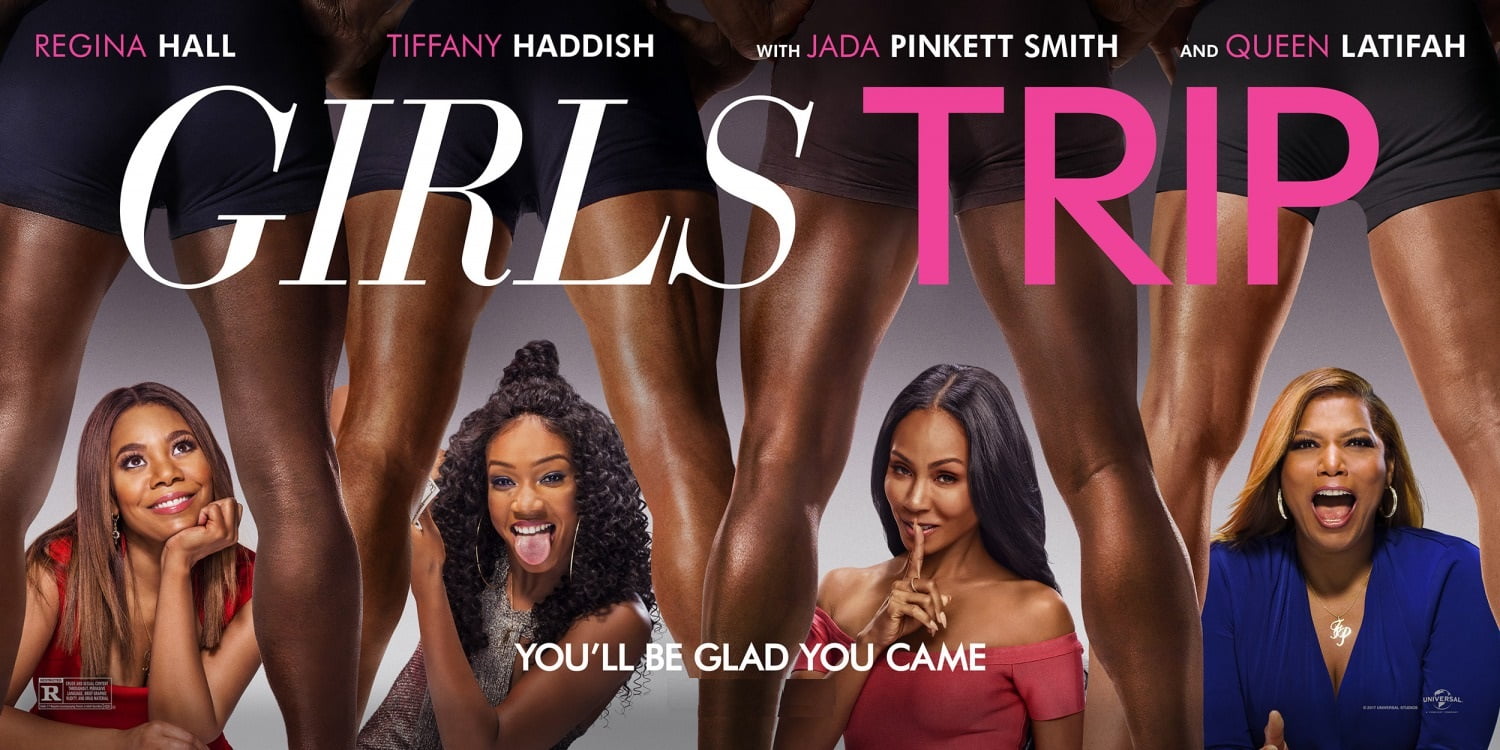It is rare to see a comedy film, starring four black women as its leads, co-written by a black woman and backed by a Hollywood studio as big as Universal Pictures, and Girls Trip (2017) is one such ‘chick-flick’. It does not try to be prim and proper, fitting its characters and their stories into the commonplace girl-next-door archetype. It delivers what it promises to be, just a movie about girls having a good time.
The story, co-written by Kenya Barris (of Black-ish fame) and Tracy Oliver (known for the 2011-13 web-series Misadventures of an Awkward Black Girl) revolves around a college quartet called ‘Flossy Posse’,—ambitious in the 90s, mostly far-from-ideal in 2017. The group comprises of Ryan Pierce (played by Regina Hall), a lifestyle-guru who seems to have it all, single mom Lisa Cooper (Jada Pinkett-Smith), celebrity gossip-blogger Sasha Franklin (Queen Latifah) and a recently-unemployed and the literal personification of a laugh-riot, Dina (Tiffany Haddish).
Ryan has been invited to speak at the Essence Festival at New Orleans about her seemingly perfect work-life balance—her job as an Oprah2.0 and her marriage to former NFL player Stewart Pierce (Mike Colter). Seeing this as a chance to reconnect with the Flossy Posse, she invites them along to join her. They have all got a set of goals they wish to achieve out of this trip—Sasha is trying her best to find content that can keep her from going broke and killing her blog, Lisa is on a mission to get her love life up and running, Ryan needs things to sail smoothly in order to land a million-dollar deal with her husband, and needs to convincingly pass off as “#goals”, while Dina is simply there to get white-boy-wasted.
It does not try to be prim and proper, fitting its characters and their stories into the commonplace girl-next-door archetype. It delivers what it promises to be, just a movie about girls having a good time.
Even Lisa getting stuck on a zip line and ending up urinating on the crowd under, or Dina’s ‘grapefruiting’ tutorials do not save the film from its obligatory doses of drama, which come up when Ryan accuses Sasha of leaking a photo of Stewart cheating on his wife with an ‘Instagram Model’. The film does find itself in a pool of cliches that threaten, and later strengthen the Flossy Posse’s sisterhood. But eventually it is the newcomer Haddish who stands out in a film that stars three other household names; her charm and comedic timing ensure that you do not take your eyes off her.
Also read: Travel and Trouble: Why Girls Cant Have all the Fun
Through all its humour and drama, outfit goals and travel tips (PSA: stay away from motels), what Girls Trip seeks to do, and succeeds at, is to turn the tables on Hollywood’s age-old portrayal of black women as manipulative, scheming and calculative women whose entire lives revolve around cat-fights and dragging each other down.
Director Malcolm D Lee (known for The Best Man, Night School) accomplishes this without selling it with over-the-top sappy and unconvincing storylines, that feel as plastic as the inside of turtles in the ocean (Psyche! This is not just a film review, it is also an alarm about the climate crisis). Using its characters raw and unfiltered personalities, Girls Trip manages to paint Black sisterhood in realer colours, contrary to that of Real Housewives of Atlanta.
What strikes the most about the film is its unapologetic, simple and real portrayal of black sisterhood. it was more than refreshing to see honest writing, showing ‘badly behaved women’ as something more than just a fantasy satisfying the male ego.
What strikes the most about the film is its unapologetic, simple and real portrayal of black sisterhood. It would have been incredibly easy to let the plot and the four characters slide into straightjacket boxes of female character tropes—the ‘virgin’, the ‘gossipmonger’, the ‘hypersexual’ and the ‘proper’. However, it was more than refreshing to see honest writing, showing ‘badly behaved women’ as something more than just a fantasy satisfying the male ego. The main goal of the film is to reconnect with your sister squad (something Veere di Wedding did attempt to do), instead of simply setting every woman’s mission to find ‘the one’, who more often than not, ends up being an overgrown man-child with a highly underwhelming personality.
Girls Trip makes sure it steps outside Hollywood’s popular tokenism of the ‘gay best friend’ and/or the ‘black best friend’. Each character has a well-defined storyline to back them up, a conflict they each have to resolve with themselves, with unadulterated love, loyalty, support and sisterhood acting as the bond between the Flossy Posse. What Bridesmaids (2015) did for women in comedy, Girls Trip seeks to do for black women. It is a little rough around the edges, but the film clearly pushes the boundaries about how women, especially black women, are allowed to be funny, which should no longer be a concept as radical as it was half a decade ago.
Also Read: Celebrate Female Friendships with Netflixs Grace and Frankie
With a run time of over two hours, it is not surprising to notice the bumpy road the film treads on, with some of its jokes falling flat. It thoroughly earns its R-rated tag, and makes for a good watch with your gal pals.
Featured Image Source: Empire Cinema
About the author(s)
Kavya is a student from Gurgaon, trying to study Economics and Sociology, but ends up spending all her time re-watching The Office. She is tiny and rolls her big eyes on those who say "i SuPpOrT wOmEn'S rIgHtS bUt NoT fEmInIsM".




